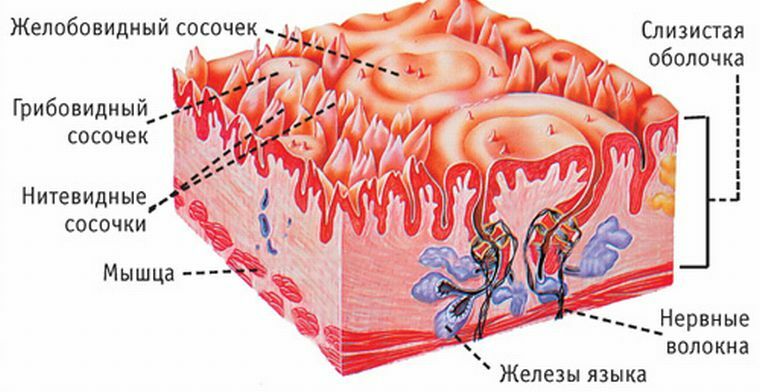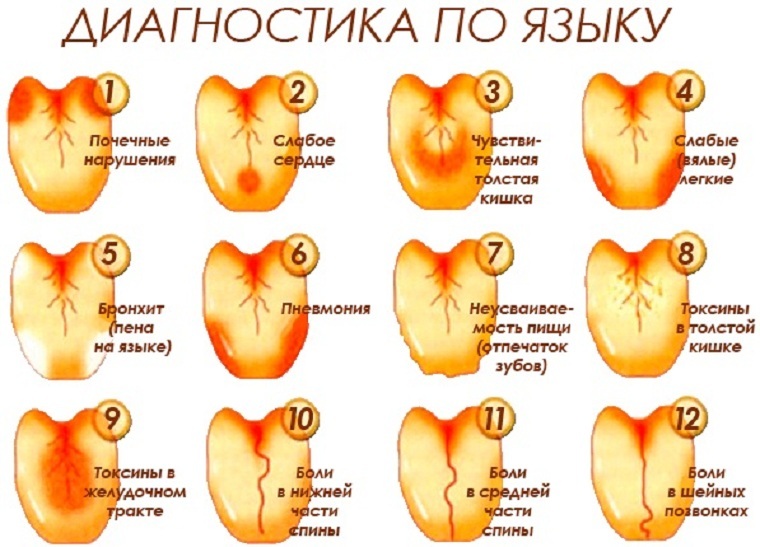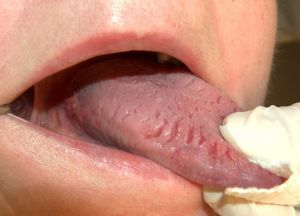 Language is not just an organ of the digestive system, but also a specific indicator that accurately tells a person how the body is feeling at the moment, whether it needs special protection or not.
Language is not just an organ of the digestive system, but also a specific indicator that accurately tells a person how the body is feeling at the moment, whether it needs special protection or not.
It is often the language that attracts attention, makes you think about whether it's time to see a doctor, despite the fact that the general condition and well-being on the whole are not alarming.
It is the state of the language that determines many diseases, even on a doctor's visit, the examination of the tongue acts as one of the diagnostic stages.
Contents
- Anatomy and functions
- What does a healthy language look like?
- All colors of the rainbow in the mouth
- Plaque formation
- Bumps at the base
- Crack formation
- Ulcers and wounds in the
- language Map of internal diseases
Anatomy and functions
The human tongue is by nature a muscular organ without bones. Above it is covered with a mucous membrane. Tasks and functions that it performs:
- participates in the work of the speech device;
- determines the taste of food that a person eats;
- is part of the digestive system - it performs the primary processing of food, mixes it and forms a food lump that pushes further into the esophagus.
The structure of the language is simple, but interesting. This organ is divided into two parts - the posterior - the root and the anterior - the body. Also, the upper surface is called the back and has a velvety texture.
The tongue is covered with papillae, which are divided into 4 groups responsible for the recognition of tastes. That is why, with a burn and other traumas of the tongue, a person temporarily loses the ability to perceive one or several tastes.

What does a healthy language look like?
The tongue healthy without any pathologies should be pink and have a fold that runs along its entire surface. Also, the  language in a normal state is soft to the touch, does not cause unpleasant sensations if it is moved by conversation or eating. Taste papillae are usually well distinguishable and pronounced.
language in a normal state is soft to the touch, does not cause unpleasant sensations if it is moved by conversation or eating. Taste papillae are usually well distinguishable and pronounced.
A small amount of white plaque is the norm for a healthy tongue. Its number can vary depending on the season. Also, the presence of a fine whitish coating indicates a minor pathology, which develops slowly, has a local location.
Bring to the appearance of the plaque can:
- caries;
- gingivitis;
- gum disease;
- candidiasis.
Gastrointestinal problems, food allergies and a lack of vitamins are the primary cause of the formation of yellow or white raids. Sealing plaque may indicate a disease, including chronic, requiring immediate attention to a specialist.
All the colors of the rainbow in the mouth
Everyone knows that the color of the language can easily determine that something is wrong with the body, as some diseases are "reflected" on it by the characteristic color of the plaque. The most common of them:
- measles or flu, high temperature - burgundy;
- lack of nutrition, anemia, heart failure - pale tongue;
- disease of the blood or respiratory tract - violet plaque;
- problems with the digestive tract, smoking, jaundice - yellow or gray plaque;
- liver disease, spleen, dysentery, abscesses, neglected viral diseases - black plaque;
- kidney disease - blue coating;
- blood circulation disorders, heavy metal poisoning, scurvy - blue plaque;
- dehydration, fungal infection - white tongue;
- Diseases of the oral cavity - dark brown plaque.
That's why it is important to pay attention to the details, since they can tell about health more than the person himself.

Plaque formation
The presence of a raid in an unhealthy color indicates that there is a change with a particular organ or even a group, there is a problem that requires attention and medical intervention. In order to accurately understand what is happening, you need to know the peculiarities of the location of the raid.
Most often, the color of the tongue and plaque is different, which makes it possible to determine an approximate system of organs that need treatment.
The thickness of the plaque indicates the severity of the problem - the thicker it is, the faster the changes that are harmful to human health.
In the event that the white coating has a thick layer, then the GI tract suffers, and the likelihood of constipation increases. If it is located a thin layer on the tip of the tongue, the main problem is gastritis. At the same time, a thick layer on the tip of the tongue speaks of complications with gastritis or that the disease has passed into a chronic form.
If plaque is located at the root of the tongue, then this is the first sign of inflammatory processes in the intestine. In the event that the plaque is gray and concentrated at the root of the tongue, then one can judge chronic diseases of the intestine and stomach, such as increased acidity.

Plaque can also be yellow or black - this is an occasion to think about the health of internal organs, among them:
- spleen;
- gallbladder;
- liver.
Most likely, the cause is the problems of the gastrointestinal tract, so a consultation with a specialist in this area is necessary to prevent the deterioration of the situation.
It is important to remember that a plaque in a language that is white may also indicate respiratory diseases, for example pneumonia.
To determine this disease, you can by gradual darkening of the plaque and its location along the edges of the tongue and on its front. If there is no darkening, then with a similar placement of plaque, you can talk about pneumonia.
Bumps at the base of
The appearance of tubercles at the base of the tongue root may indicate an increase in tonsils. To correct the situation at home, you can wash the nose with special means, but it will be best to consult a doctor, since a full survey will reveal the exact cause of their appearance.
Crack formation
 The tongue does not always have a perfectly flat surface. Often, it can observe cracks. If there are a lot of them, then such language is called "geographical", it can testify that the problems with the gastrointestinal tract have passed into a chronic form, and also that mental disorders are possible.
The tongue does not always have a perfectly flat surface. Often, it can observe cracks. If there are a lot of them, then such language is called "geographical", it can testify that the problems with the gastrointestinal tract have passed into a chronic form, and also that mental disorders are possible.
In addition, many cracks in the tongue speak of:
- disorders in the work of the brain departments;
- the presence of an allergic reaction;
- somatic disorders in the body.
Also, if there are cracks in the tongue, it is necessary to consult a doctor, since the abnormality of the sublingual nerve is probable.
It can be recognized if, together with cracks, there is a deviation of the tongue to the side. On the location of cracks, the side on which the organs experience a load or disease is diagnosed.
For example, if they are exactly in the middle of the tongue, then there is a high probability of problems with the spine. A curved crack located at the root of the tongue indicates problems in the lumbar region, at the tip of the tongue, then in the cervical region.
Ulcers and wounds in the
language Ulcers on the surface of the tongue are not a rare occurrence and can occur for a variety of reasons:
- trauma to the tongue;
- burn;
- dental problems in the oral cavity;
- Crohn's disease and other gastrointestinal problems.
Usually sores are small in size, but are present in large numbers, so they bring a lot of inconvenience and discomfort to a person. To leave without attention wounds and ulcers in the tongue, especially if they have arisen without a reason, it is impossible.
One type of disease in which the body gives such a symptom is syphilis, therefore, treatment should be prompt and professional. However, in the case of this disease, the sore will be present in the language in the singular.
Its surface is bright red, shiny and hard. In addition, it is completely painless. The formation of warts at the root of the tongue or along its sides is a sign of HIV, and flat ulcers at the tip of the tongue, lateral sections or along the median line, indicate the onset of tuberculosis.
Map of diseases of internal organs
Language is called a card of diseases of organs not by chance. Each of them corresponds to its own place. So in Chinese medicine, the division of the surface of the tongue into three parts is accepted:
- root - the lower part of the body and the organs located below;
- the body of the tongue - the middle part of the body;
- tip - upper body.

There is another division, where the place in the language is assigned to the body. So the front part of the tongue surface tells about the health of the liver, heart and lungs, the middle gives an understanding of how the stomach, pancreas and spleen works. The root of the tongue helps in the diagnosis of the intestine. The lateral parts of the tongue let you know how the kidneys work.
About what diseases speaks the color of the language - Elena Malysheva knows:
Thus, the language is a universal way to quickly and accurately conduct a diagnosis of the internal organs. Its value for man is not limited to food processing and participation in speech formation, since language is a real doctor who will always help to recognize the most complex disease.
Emerging changes should be taken into account, as they indicate the emergence and development of pathologies and changes in the body. It is necessary not only to notice signs of the disease in a timely manner, but also to take prompt measures to eliminate it - contact a doctor.
